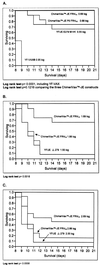Single mutation in the flavivirus envelope protein hinge region increases neurovirulence for mice and monkeys but decreases viscerotropism for monkeys: relevance to development and safety testing of live, attenuated vaccines
- PMID: 11799188
- PMCID: PMC135909
- DOI: 10.1128/jvi.76.4.1932-1943.2002
Single mutation in the flavivirus envelope protein hinge region increases neurovirulence for mice and monkeys but decreases viscerotropism for monkeys: relevance to development and safety testing of live, attenuated vaccines
Abstract
A chimeric yellow fever (YF) virus/Japanese encephalitis (JE) virus vaccine (ChimeriVax-JE) was constructed by insertion of the prM-E genes from the attenuated JE virus SA14-14-2 vaccine strain into a full-length cDNA clone of YF 17D virus. Passage in fetal rhesus lung (FRhL) cells led to the emergence of a small-plaque virus containing a single Met-->Lys amino acid mutation at E279, reverting this residue from the SA14-14-2 to the wild-type amino acid. A similar virus was also constructed by site-directed mutagenesis (J. Arroyo, F. Guirakhoo, S. Fenner, Z.-X. Zhang, T. P. Monath, and T. J. Chambers, J. Virol. 75:934-942, 2001). The E279 mutation is located in a beta-sheet in the hinge region of the E protein that is responsible for a pH-dependent conformational change during virus penetration from the endosome into the cytoplasm of the infected cell. In independent transfection-passage studies with FRhL or Vero cells, mutations appeared most frequently in hinge 4 (bounded by amino acids E266 to E284), reflecting genomic instability in this functionally important region. The E279 reversion caused a significant increase in neurovirulence as determined by the 50% lethal dose and survival distribution in suckling mice and by histopathology in rhesus monkeys. Based on sensitivity and comparability of results with those for monkeys, the suckling mouse is an appropriate host for safety testing of flavivirus vaccine candidates for neurotropism. After intracerebral inoculation, the E279 Lys virus was restricted with respect to extraneural replication in monkeys, as viremia and antibody levels (markers of viscerotropism) were significantly reduced compared to those for the E279 Met virus. These results are consistent with the observation that empirically derived vaccines developed by mouse brain passage of dengue and YF viruses have increased neurovirulence for mice but reduced viscerotropism for humans.
Figures





Similar articles
-
Chimeric yellow fever virus 17D-Japanese encephalitis virus vaccine: dose-response effectiveness and extended safety testing in rhesus monkeys.J Virol. 2000 Feb;74(4):1742-51. doi: 10.1128/jvi.74.4.1742-1751.2000. J Virol. 2000. PMID: 10644345 Free PMC article.
-
A single amino acid substitution in the envelope protein of chimeric yellow fever-dengue 1 vaccine virus reduces neurovirulence for suckling mice and viremia/viscerotropism for monkeys.J Virol. 2004 Sep;78(18):9998-10008. doi: 10.1128/JVI.78.18.9998-10008.2004. J Virol. 2004. PMID: 15331733 Free PMC article.
-
Recombinant, chimaeric live, attenuated vaccine (ChimeriVax) incorporating the envelope genes of Japanese encephalitis (SA14-14-2) virus and the capsid and nonstructural genes of yellow fever (17D) virus is safe, immunogenic and protective in non-human primates.Vaccine. 1999 Apr 9;17(15-16):1869-82. doi: 10.1016/s0264-410x(98)00487-3. Vaccine. 1999. PMID: 10217584
-
Phenotypic and genotypic characteristics of Japanese encephalitis attenuated live vaccine virus SA14-14-2 and their stabilities.Vaccine. 2010 May 7;28(21):3635-41. doi: 10.1016/j.vaccine.2010.02.105. Epub 2010 Mar 11. Vaccine. 2010. PMID: 20226891 Review.
-
Live virus vaccines based on a yellow fever vaccine backbone: standardized template with key considerations for a risk/benefit assessment.Vaccine. 2015 Jan 1;33(1):62-72. doi: 10.1016/j.vaccine.2014.10.004. Epub 2014 Oct 27. Vaccine. 2015. PMID: 25446819 Free PMC article. Review.
Cited by
-
Genotype Change in Circulating JEV Strains in Fujian Province, China.Viruses. 2023 Aug 26;15(9):1822. doi: 10.3390/v15091822. Viruses. 2023. PMID: 37766229 Free PMC article.
-
A molecularly cloned, live-attenuated japanese encephalitis vaccine SA14-14-2 virus: a conserved single amino acid in the ij Hairpin of the Viral E glycoprotein determines neurovirulence in mice.PLoS Pathog. 2014 Jul 31;10(7):e1004290. doi: 10.1371/journal.ppat.1004290. eCollection 2014 Jul. PLoS Pathog. 2014. PMID: 25077483 Free PMC article.
-
The key amino acids of E protein involved in early flavivirus infection: viral entry.Virol J. 2021 Jul 3;18(1):136. doi: 10.1186/s12985-021-01611-2. Virol J. 2021. PMID: 34217298 Free PMC article. Review.
-
Rhesus macaque antibody molecules: sequences and heterogeneity of alpha and gamma constant regions.Immunology. 2004 Jan;111(1):66-74. doi: 10.1111/j.1365-2567.2004.01767.x. Immunology. 2004. PMID: 14678200 Free PMC article.
-
High-throughput automated image analysis of neuroinflammation and neurodegeneration enables quantitative assessment of virus neurovirulence.Vaccine. 2010 Dec 6;28(52):8315-26. doi: 10.1016/j.vaccine.2010.07.070. Epub 2010 Aug 3. Vaccine. 2010. PMID: 20688036 Free PMC article.
References
-
- Aihara, S., C. M. Rao, Y. X. Yu, T. Lee, K. Watanabe, T. Komiya, H. Sumiyoshi, H. Hashimoto, and A. Nomoto. 1991. Identification of mutations that occurred on the genome of Japanese encephalitis virus during the attenuation process. Virus Genes 5:95-109. - PubMed
MeSH terms
Substances
LinkOut - more resources
Full Text Sources
Other Literature Sources
Miscellaneous

